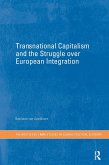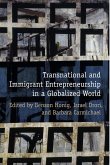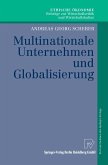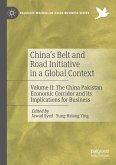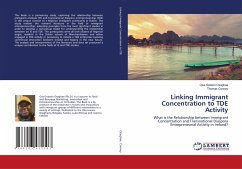Marten Boon
Multinational Business and Transnational Regions
A Transnational Business History of Energy Transition in the Rhine Region, 1945-1973
Marten Boon
Multinational Business and Transnational Regions
A Transnational Business History of Energy Transition in the Rhine Region, 1945-1973
- Gebundenes Buch
- Merkliste
- Auf die Merkliste
- Bewerten Bewerten
- Teilen
- Produkt teilen
- Produkterinnerung
- Produkterinnerung
Multinational Enterprise and Transnational Regions offers an innovative transnational approach to the study of the history of economic regions. The historiography of the economic development of the Rhine region, a transnational economic region loosely comprising the cities and areas in the Rhine basin, has traditionally focused on the local and national histories of its constituent parts.
Andere Kunden interessierten sich auch für
![Transnational Capitalism and the Struggle over European Integration Transnational Capitalism and the Struggle over European Integration]() Bastiaan Van ApeldoornTransnational Capitalism and the Struggle over European Integration167,99 €
Bastiaan Van ApeldoornTransnational Capitalism and the Struggle over European Integration167,99 €![Transnational and Immigrant Entrepreneurship in a Globalized World Transnational and Immigrant Entrepreneurship in a Globalized World]() Transnational and Immigrant Entrepreneurship in a Globalized World65,99 €
Transnational and Immigrant Entrepreneurship in a Globalized World65,99 €![Transnational Corporations and Underdevelopment Transnational Corporations and Underdevelopment]() Volker BornschierTransnational Corporations and Underdevelopment71,99 €
Volker BornschierTransnational Corporations and Underdevelopment71,99 €![Multinational Enterprises and Innovation Multinational Enterprises and Innovation]() Martin HeidenreichMultinational Enterprises and Innovation186,99 €
Martin HeidenreichMultinational Enterprises and Innovation186,99 €![Multinationale Unternehmen und Globalisierung Multinationale Unternehmen und Globalisierung]() Andreas G. SchererMultinationale Unternehmen und Globalisierung89,99 €
Andreas G. SchererMultinationale Unternehmen und Globalisierung89,99 €![China's Belt and Road Initiative in a Global Context China's Belt and Road Initiative in a Global Context]() China's Belt and Road Initiative in a Global Context121,99 €
China's Belt and Road Initiative in a Global Context121,99 €![Linking Immigrant Concentration to TDE Activity Linking Immigrant Concentration to TDE Activity]() Osa-Godwin OsaghaeLinking Immigrant Concentration to TDE Activity55,99 €
Osa-Godwin OsaghaeLinking Immigrant Concentration to TDE Activity55,99 €-
-
-
Multinational Enterprise and Transnational Regions offers an innovative transnational approach to the study of the history of economic regions. The historiography of the economic development of the Rhine region, a transnational economic region loosely comprising the cities and areas in the Rhine basin, has traditionally focused on the local and national histories of its constituent parts.
Produktdetails
- Produktdetails
- Verlag: Routledge
- Seitenzahl: 250
- Erscheinungstermin: 26. März 2018
- Englisch
- Abmessung: 235mm x 157mm x 18mm
- Gewicht: 518g
- ISBN-13: 9781138210127
- ISBN-10: 1138210129
- Artikelnr.: 52712751
- Herstellerkennzeichnung
- Libri GmbH
- Europaallee 1
- 36244 Bad Hersfeld
- gpsr@libri.de
- Verlag: Routledge
- Seitenzahl: 250
- Erscheinungstermin: 26. März 2018
- Englisch
- Abmessung: 235mm x 157mm x 18mm
- Gewicht: 518g
- ISBN-13: 9781138210127
- ISBN-10: 1138210129
- Artikelnr.: 52712751
- Herstellerkennzeichnung
- Libri GmbH
- Europaallee 1
- 36244 Bad Hersfeld
- gpsr@libri.de
Marten Boon is Postdoctoral Fellow at the Department of History at Norwegian University of Science and Technology, Trondheim.
Introduction
Transnational economic regions: capturing an illusive phenomenon
Resurrecting the Rhine as an economic region
Energy transition in the Rhine region
Part I Regional transformation - Energy transition in the Rhine region
Chapter 1 The post-war reconstruction and the rise of oil, 1945-1951
1.1 Introduction
1.2 The question of energy in post-war Western Europe
1.3 The impact of the Allied occupation on the Ruhr coal industry
1.4 The Allied refining program: restarting the hydrogenation plants
1.5 The case of Union Kraftstoff
1.6 The geographical consequences of the Allied occupation
1.7 Conclusion
Chapter 2 Oil unbounded: The Coal Crisis of 1957-8
2.1 Introduction
2.2 The competition between coal and oil, 1950-1955
2.3 The rise of fuel oil and the 1958 coal crisis
2.4 Stemming the tide: attempts to limit the rise of fuel oil
2.5 Conclusion
Chapter 3 The growth of chemical clusters in the Rhine region, 1960-73
3.1 Introduction
3.2 The Rhine-Ruhr refineries
3.3 Deutsche Shell and Union Kraftstoff, 1951-1958
3.4 The Rhineland refinery of Deutsche Shell
3.5 The post-war transition of the chemical industry
3.6 An oil and petrochemical cluster in the Rhine-Ruhr area
3.7 Effect of the transition on transport demand in the hinterland
3.8 Conclusions
Part II Regional connections - From Rhine to pipeline
Chapter 4 Pipelines: The national approach, 1955-6
4.1 Introduction
4.2 A pipeline to the Rhine-Ruhr area
4.3 Rotterdam competing with Wilhelmshaven
4.4 Wilhelmshaven: "the best deep water port in Europe"?
4.5 Conclusions
Chapter 5 The trans-European pipeline: The transnational approach: 1956-8
5.1 Introduction
5.2 From national to transnational: the trans-European pipeline plan
5.3 Further complications
5.4 France, oil and the Cold War
5.5 Endgame: The failure of the trans-European pipeline
5.6 Why the trans-European pipeline never materialised
5.7 Conclusion
Chapter 6 Expanding transnational connections, 1959-73
6.1 Introduction
6.2 The hydrocarbon hub: The Rotterdam port between 1950 and 1973
6.3 The expansion of the Rotterdam-Rhine pipeline, 1965-1968
6.4 The Rhine-Main pipeline, 1965-1971
6.5 Integrating chemical clusters in the Rhine basin, 1965-73
6.6 The Rotterdam-Antwerp pipeline, 1967-1969
6.7 Conclusion
Chapter 7 Transnational connections in the Rhine region: Evidence from
transport flows
7.1 Introduction
7.2 Gateway to the Rhine? Rotterdam from transitopolis to industrial port
7.3 Oil flows in the Rhine region: The impact of pipelines
7.4 Transnational connections
7.5 Conclusion
Chapter 8 Conclusion
Transnational economic regions: capturing an illusive phenomenon
Resurrecting the Rhine as an economic region
Energy transition in the Rhine region
Part I Regional transformation - Energy transition in the Rhine region
Chapter 1 The post-war reconstruction and the rise of oil, 1945-1951
1.1 Introduction
1.2 The question of energy in post-war Western Europe
1.3 The impact of the Allied occupation on the Ruhr coal industry
1.4 The Allied refining program: restarting the hydrogenation plants
1.5 The case of Union Kraftstoff
1.6 The geographical consequences of the Allied occupation
1.7 Conclusion
Chapter 2 Oil unbounded: The Coal Crisis of 1957-8
2.1 Introduction
2.2 The competition between coal and oil, 1950-1955
2.3 The rise of fuel oil and the 1958 coal crisis
2.4 Stemming the tide: attempts to limit the rise of fuel oil
2.5 Conclusion
Chapter 3 The growth of chemical clusters in the Rhine region, 1960-73
3.1 Introduction
3.2 The Rhine-Ruhr refineries
3.3 Deutsche Shell and Union Kraftstoff, 1951-1958
3.4 The Rhineland refinery of Deutsche Shell
3.5 The post-war transition of the chemical industry
3.6 An oil and petrochemical cluster in the Rhine-Ruhr area
3.7 Effect of the transition on transport demand in the hinterland
3.8 Conclusions
Part II Regional connections - From Rhine to pipeline
Chapter 4 Pipelines: The national approach, 1955-6
4.1 Introduction
4.2 A pipeline to the Rhine-Ruhr area
4.3 Rotterdam competing with Wilhelmshaven
4.4 Wilhelmshaven: "the best deep water port in Europe"?
4.5 Conclusions
Chapter 5 The trans-European pipeline: The transnational approach: 1956-8
5.1 Introduction
5.2 From national to transnational: the trans-European pipeline plan
5.3 Further complications
5.4 France, oil and the Cold War
5.5 Endgame: The failure of the trans-European pipeline
5.6 Why the trans-European pipeline never materialised
5.7 Conclusion
Chapter 6 Expanding transnational connections, 1959-73
6.1 Introduction
6.2 The hydrocarbon hub: The Rotterdam port between 1950 and 1973
6.3 The expansion of the Rotterdam-Rhine pipeline, 1965-1968
6.4 The Rhine-Main pipeline, 1965-1971
6.5 Integrating chemical clusters in the Rhine basin, 1965-73
6.6 The Rotterdam-Antwerp pipeline, 1967-1969
6.7 Conclusion
Chapter 7 Transnational connections in the Rhine region: Evidence from
transport flows
7.1 Introduction
7.2 Gateway to the Rhine? Rotterdam from transitopolis to industrial port
7.3 Oil flows in the Rhine region: The impact of pipelines
7.4 Transnational connections
7.5 Conclusion
Chapter 8 Conclusion
Introduction
Transnational economic regions: capturing an illusive phenomenon
Resurrecting the Rhine as an economic region
Energy transition in the Rhine region
Part I Regional transformation - Energy transition in the Rhine region
Chapter 1 The post-war reconstruction and the rise of oil, 1945-1951
1.1 Introduction
1.2 The question of energy in post-war Western Europe
1.3 The impact of the Allied occupation on the Ruhr coal industry
1.4 The Allied refining program: restarting the hydrogenation plants
1.5 The case of Union Kraftstoff
1.6 The geographical consequences of the Allied occupation
1.7 Conclusion
Chapter 2 Oil unbounded: The Coal Crisis of 1957-8
2.1 Introduction
2.2 The competition between coal and oil, 1950-1955
2.3 The rise of fuel oil and the 1958 coal crisis
2.4 Stemming the tide: attempts to limit the rise of fuel oil
2.5 Conclusion
Chapter 3 The growth of chemical clusters in the Rhine region, 1960-73
3.1 Introduction
3.2 The Rhine-Ruhr refineries
3.3 Deutsche Shell and Union Kraftstoff, 1951-1958
3.4 The Rhineland refinery of Deutsche Shell
3.5 The post-war transition of the chemical industry
3.6 An oil and petrochemical cluster in the Rhine-Ruhr area
3.7 Effect of the transition on transport demand in the hinterland
3.8 Conclusions
Part II Regional connections - From Rhine to pipeline
Chapter 4 Pipelines: The national approach, 1955-6
4.1 Introduction
4.2 A pipeline to the Rhine-Ruhr area
4.3 Rotterdam competing with Wilhelmshaven
4.4 Wilhelmshaven: "the best deep water port in Europe"?
4.5 Conclusions
Chapter 5 The trans-European pipeline: The transnational approach: 1956-8
5.1 Introduction
5.2 From national to transnational: the trans-European pipeline plan
5.3 Further complications
5.4 France, oil and the Cold War
5.5 Endgame: The failure of the trans-European pipeline
5.6 Why the trans-European pipeline never materialised
5.7 Conclusion
Chapter 6 Expanding transnational connections, 1959-73
6.1 Introduction
6.2 The hydrocarbon hub: The Rotterdam port between 1950 and 1973
6.3 The expansion of the Rotterdam-Rhine pipeline, 1965-1968
6.4 The Rhine-Main pipeline, 1965-1971
6.5 Integrating chemical clusters in the Rhine basin, 1965-73
6.6 The Rotterdam-Antwerp pipeline, 1967-1969
6.7 Conclusion
Chapter 7 Transnational connections in the Rhine region: Evidence from
transport flows
7.1 Introduction
7.2 Gateway to the Rhine? Rotterdam from transitopolis to industrial port
7.3 Oil flows in the Rhine region: The impact of pipelines
7.4 Transnational connections
7.5 Conclusion
Chapter 8 Conclusion
Transnational economic regions: capturing an illusive phenomenon
Resurrecting the Rhine as an economic region
Energy transition in the Rhine region
Part I Regional transformation - Energy transition in the Rhine region
Chapter 1 The post-war reconstruction and the rise of oil, 1945-1951
1.1 Introduction
1.2 The question of energy in post-war Western Europe
1.3 The impact of the Allied occupation on the Ruhr coal industry
1.4 The Allied refining program: restarting the hydrogenation plants
1.5 The case of Union Kraftstoff
1.6 The geographical consequences of the Allied occupation
1.7 Conclusion
Chapter 2 Oil unbounded: The Coal Crisis of 1957-8
2.1 Introduction
2.2 The competition between coal and oil, 1950-1955
2.3 The rise of fuel oil and the 1958 coal crisis
2.4 Stemming the tide: attempts to limit the rise of fuel oil
2.5 Conclusion
Chapter 3 The growth of chemical clusters in the Rhine region, 1960-73
3.1 Introduction
3.2 The Rhine-Ruhr refineries
3.3 Deutsche Shell and Union Kraftstoff, 1951-1958
3.4 The Rhineland refinery of Deutsche Shell
3.5 The post-war transition of the chemical industry
3.6 An oil and petrochemical cluster in the Rhine-Ruhr area
3.7 Effect of the transition on transport demand in the hinterland
3.8 Conclusions
Part II Regional connections - From Rhine to pipeline
Chapter 4 Pipelines: The national approach, 1955-6
4.1 Introduction
4.2 A pipeline to the Rhine-Ruhr area
4.3 Rotterdam competing with Wilhelmshaven
4.4 Wilhelmshaven: "the best deep water port in Europe"?
4.5 Conclusions
Chapter 5 The trans-European pipeline: The transnational approach: 1956-8
5.1 Introduction
5.2 From national to transnational: the trans-European pipeline plan
5.3 Further complications
5.4 France, oil and the Cold War
5.5 Endgame: The failure of the trans-European pipeline
5.6 Why the trans-European pipeline never materialised
5.7 Conclusion
Chapter 6 Expanding transnational connections, 1959-73
6.1 Introduction
6.2 The hydrocarbon hub: The Rotterdam port between 1950 and 1973
6.3 The expansion of the Rotterdam-Rhine pipeline, 1965-1968
6.4 The Rhine-Main pipeline, 1965-1971
6.5 Integrating chemical clusters in the Rhine basin, 1965-73
6.6 The Rotterdam-Antwerp pipeline, 1967-1969
6.7 Conclusion
Chapter 7 Transnational connections in the Rhine region: Evidence from
transport flows
7.1 Introduction
7.2 Gateway to the Rhine? Rotterdam from transitopolis to industrial port
7.3 Oil flows in the Rhine region: The impact of pipelines
7.4 Transnational connections
7.5 Conclusion
Chapter 8 Conclusion


